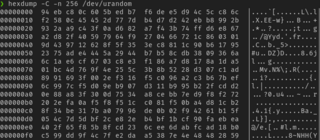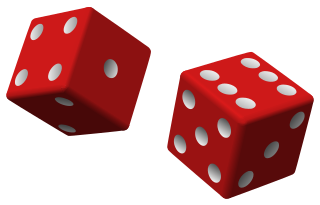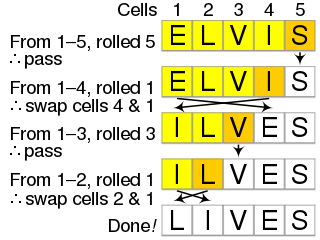A pseudorandom sequence of numbers is one that appears to be statistically random, despite having been produced by a completely deterministic and repeatable process.
In mathematics and statistics, a random number is either Pseudo-random or a number generated for, or part of, a set exhibiting statistical randomness.
A pseudorandom number generator (PRNG), also known as a deterministic random bit generator (DRBG), is an algorithm for generating a sequence of numbers whose properties approximate the properties of sequences of random numbers. The PRNG-generated sequence is not truly random, because it is completely determined by an initial value, called the PRNG's seed. Although sequences that are closer to truly random can be generated using hardware random number generators, pseudorandom number generators are important in practice for their speed in number generation and their reproducibility.

A linear congruential generator (LCG) is an algorithm that yields a sequence of pseudo-randomized numbers calculated with a discontinuous piecewise linear equation. The method represents one of the oldest and best-known pseudorandom number generator algorithms. The theory behind them is relatively easy to understand, and they are easily implemented and fast, especially on computer hardware which can provide modular arithmetic by storage-bit truncation.
The Mersenne Twister is a general-purpose pseudorandom number generator (PRNG) developed in 1997 by Makoto Matsumoto and Takuji Nishimura. Its name derives from the fact that its period length is chosen to be a Mersenne prime.
In computing, a linear-feedback shift register (LFSR) is a shift register whose input bit is a linear function of its previous state.

In computing, a hardware random number generator (HRNG) or true random number generator (TRNG) is a device that generates random numbers from a physical process, rather than by means of an algorithm. Such devices are often based on microscopic phenomena that generate low-level, statistically random "noise" signals, such as thermal noise, the photoelectric effect, involving a beam splitter, and other quantum phenomena. These stochastic processes are, in theory, completely unpredictable for as long as an equation governing such phenomena is unknown or uncomputable. This is in contrast to the paradigm of pseudo-random number generation commonly implemented in computer programs.

A Premium Bond is a lottery bond issued by the United Kingdom government since 1956. At present it is issued by the government's National Savings and Investments agency.
A cryptographically secure pseudorandom number generator (CSPRNG) or cryptographic pseudorandom number generator (CPRNG) is a pseudorandom number generator (PRNG) with properties that make it suitable for use in cryptography. It is also loosely known as a cryptographic random number generator (CRNG).

In Unix-like operating systems, /dev/random and /dev/urandom are special files that serve as cryptographically secure pseudorandom number generators. They allow access to environmental noise collected from device drivers and other sources. /dev/random typically blocked if there was less entropy available than requested; more recently it usually blocks at startup until sufficient entropy has been gathered, then unblocks permanently. The /dev/urandom device typically was never a blocking device, even if the pseudorandom number generator seed was not fully initialized with entropy since boot. Not all operating systems implement the same methods for /dev/random and /dev/urandom.
The security of cryptographic systems depends on some secret data that is known to authorized persons but unknown and unpredictable to others. To achieve this unpredictability, some randomization is typically employed. Modern cryptographic protocols often require frequent generation of random quantities. Cryptographic attacks that subvert or exploit weaknesses in this process are known as random number generator attacks.
A random password generator is software program or hardware device that takes input from a random or pseudo-random number generator and automatically generates a password. Random passwords can be generated manually, using simple sources of randomness such as dice or coins, or they can be generated using a computer.
George Marsaglia was an American mathematician and computer scientist. He is best known for creating the diehard tests, a suite of software for measuring statistical randomness.
Randomness has many uses in science, art, statistics, cryptography, gaming, gambling, and other fields. For example, random assignment in randomized controlled trials helps scientists to test hypotheses, and random numbers or pseudorandom numbers help video games such as video poker.

Random number generation is a process by which, often by means of a random number generator (RNG), a sequence of numbers or symbols that cannot be reasonably predicted better than by random chance is generated. This means that the particular outcome sequence will contain some patterns detectable in hindsight but unpredictable to foresight. True random number generators can be hardware random-number generators (HRNGS) that generate random numbers, wherein each generation is a function of the current value of a physical environment's attribute that is constantly changing in a manner that is practically impossible to model. This would be in contrast to so-called "random number generations" done by pseudorandom number generators (PRNGs) that generate numbers that only look random but are in fact pre-determined—these generations can be reproduced simply by knowing the state of the PRNG.

Password strength is a measure of the effectiveness of a password against guessing or brute-force attacks. In its usual form, it estimates how many trials an attacker who does not have direct access to the password would need, on average, to guess it correctly. The strength of a password is a function of length, complexity, and unpredictability.

The Fisher–Yates shuffle is an algorithm for generating a random permutation of a finite sequence—in plain terms, the algorithm shuffles the sequence. The algorithm effectively puts all the elements into a hat; it continually determines the next element by randomly drawing an element from the hat until no elements remain. The algorithm produces an unbiased permutation: every permutation is equally likely. The modern version of the algorithm is efficient: it takes time proportional to the number of items being shuffled and shuffles them in place.

Atmospheric noise is radio noise caused by natural atmospheric processes, primarily lightning discharges in thunderstorms. On a worldwide scale, there are about 40 lightning flashes per second – ≈3.5 million lightning discharges per day.

In common usage, randomness is the apparent or actual lack of pattern or predictability in events. A random sequence of events, symbols or steps often has no order and does not follow an intelligible pattern or combination. Individual random events are, by definition, unpredictable, but if the probability distribution is known, the frequency of different outcomes over repeated events is predictable. For example, when throwing two dice, the outcome of any particular roll is unpredictable, but a sum of 7 will tend to occur twice as often as 4. In this view, randomness is not haphazardness; it is a measure of uncertainty of an outcome. Randomness applies to concepts of chance, probability, and information entropy.
RDRAND is an instruction for returning random numbers from an Intel on-chip hardware random number generator which has been seeded by an on-chip entropy source. Intel introduced the feature around 2012, and AMD added support for the instruction in June 2015.









